Etude de bruit de fond induit par les muons dans l'expérience ...
Etude de bruit de fond induit par les muons dans l'expérience ...
Etude de bruit de fond induit par les muons dans l'expérience ...
Create successful ePaper yourself
Turn your PDF publications into a flip-book with our unique Google optimized e-Paper software.
tel-00724955, version 1 - 23 Aug 2012<br />
3<br />
72 The EDELWEISS-II experiment<br />
The data are saved in three different formats per Run : some data event fi<strong>les</strong>,<br />
a scaler file and a <strong>par</strong>ameter file.<br />
The data fi<strong>les</strong> have all necessary information for data analysis, as <strong>de</strong>tailed in the<br />
Table 3.1. The hea<strong>de</strong>r of an event is ma<strong>de</strong> of the variab<strong>les</strong> event number, geometry,<br />
multiplicity and size. The geometry gives a reference to the si<strong>de</strong>(s) of the muon<br />
veto system which got a hit. The multiplicity is the number of TDC with a signal,<br />
plus the TDC of the common stop. For example, an event, which makes an internal<br />
coinci<strong>de</strong>nce in a module, has the two TDC of each si<strong>de</strong>s, plus the common stop,<br />
which means a multiplicity multiveto = 3. The size is the size of the data blocks.<br />
After the hea<strong>de</strong>r is registered the time stamp of the event, which comes from the<br />
bolometer system via a fiber connection. The time stamp is a pattern of 48 bits<br />
of 64-ns width with an additional start bit. As the veto system runs on a 32-bit<br />
processor, the time stamp is split into three times 16 bits and saved into three 32-bit<br />
words. The time stamp has a precision of 10 µs. The local computer time, which<br />
have only a precision of the or<strong>de</strong>r of 1 s, is not registered with the event, except in<br />
the very rare case when no time is transferred from the bolometer system. In this<br />
case, the time is registered using all the 32 bits of the first word. Then, are saved<br />
the data blocks, which contain the information about the TDC and ADC entries.<br />
Data fi<strong>les</strong> have a 8-hour-length, and there are up to 99 event fi<strong>les</strong> in a Run. If more,<br />
a new Run starts (so a new Run does not mean a restart of the DAQ).<br />
The scaler file is used for monitoring and is registered every 15 min, or as specified<br />
into the input file of the DAQ software. If a new Run starts during a continuous<br />
running period, a new scaler file is created in the new Run fol<strong>de</strong>r. The <strong>par</strong>ameter<br />
file summarizes the <strong>par</strong>ameters of a running period. It is created at the beginning<br />
of the DAQ program from the input file and is then exported to the new Run fol<strong>de</strong>r.<br />
Data acquisition typically runs continuously but is interrupted e.g. when the<br />
HV has to be switched off. HV are switched off for the safety of the people in the<br />
clean room and to protect the veto system from disturbances, when critical works<br />
are being performed or when there are maintenance periods on the bolometers.<br />
On Figure 3.13, one can see long periods with almost continuous data acquisition<br />
interrupted by electric power cuts in the LSM laboratory as well as extensive work<br />
going on in the clean room of the experiment, when the high voltage of the veto<br />
system was switched off for safety reasons. Above the rather constant raw data<br />
rate, there are periods with much higher event rates which could be i<strong>de</strong>ntified as<br />
maintenance intervals of the cryostat/clean room in which the upper (mobile) veto<br />
modu<strong>les</strong> were moved with the polyethylene shielding, or when radioactive sources<br />
were being manipulated.<br />
Since July 2006, the muon veto system is stable in terms of hardware, we consi<strong>de</strong>r<br />
the recor<strong>de</strong>d event data as exploitable since then.<br />
3.3.3 Online monitoring<br />
The monitoring of the muon veto system is ma<strong>de</strong> with the data collected through<br />
the scaler cards. A scaler card is a counter. The scaler data are raw data ma<strong>de</strong><br />
of any hit in the system, where no module coinci<strong>de</strong>nce is required, and are helpful<br />
to monitor the system. With a rate of 8 kHz for the overall system, which can be<br />
arbitrary changed with the settings of the threshold, these are mainly composed<br />
On the contrary to the bolometers, a Run is ma<strong>de</strong> of some fi<strong>les</strong> and a continuous period of<br />
data acquisition, i.e. a running period, can stretch over several Runs during some months.


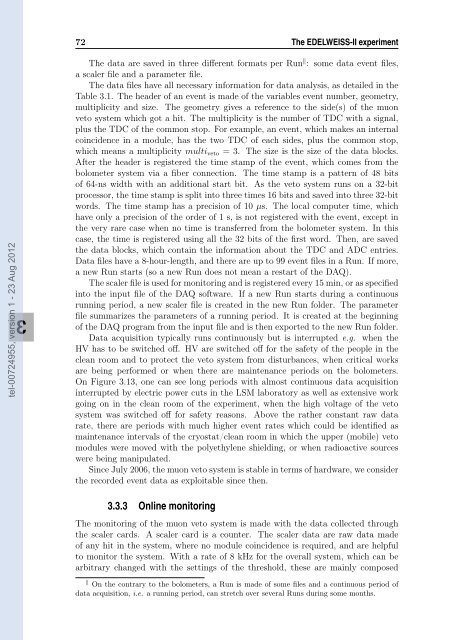

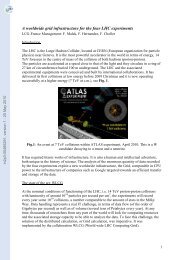

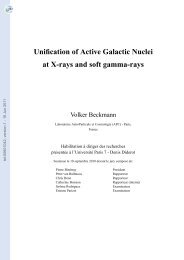

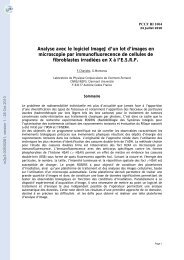
![[in2p3-00383985, v1] NUCLEAR PHYSICS at GANIL ... - HAL - IN2P3](https://img.yumpu.com/19016755/1/185x260/in2p3-00383985-v1-nuclear-physics-at-ganil-hal-in2p3.jpg?quality=85)
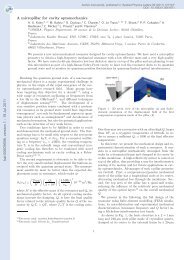
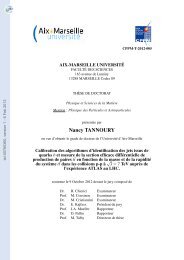
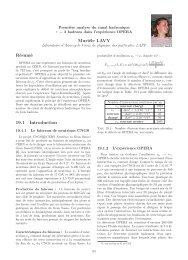
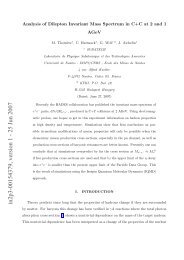
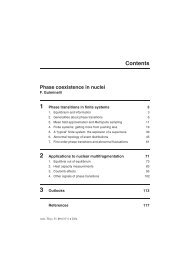
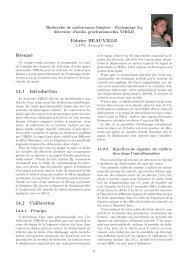
![[tel-00752304, v1] Pions réels et virtuels dans les noyaux](https://img.yumpu.com/19016523/1/184x260/tel-00752304-v1-pions-reels-et-virtuels-dans-les-noyaux.jpg?quality=85)